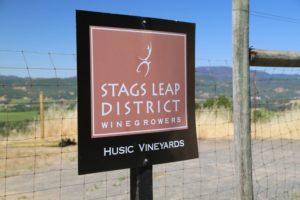

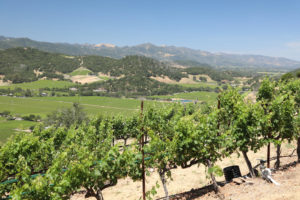 Husic Vineyards was founded by Frank and Julie Husic. Frank died in early 2024; he was originally from Youngstown, Ohio and was involved in investment and financial planning. He operated Husic Capital Management (based in San Francisco) for several decades. Julie’s background is in hospitality including providing catering services for Marriott Hotels. Both Frank and Julie met in 1994, and began looking for hillside properties in particular. In 1995, they purchased a 120 acre mostly hillside property partially located in the Stags Leap District. Intrigued by prominent vineyard neighbors they began to inquire about planting their own vineyard. Asking neighbors and others they were directed to several vineyard managers – but the ones Julie initially spoke to didn’t want to “come down valley”. Eventually she met Jim Barbour; he walked the property with her and identified several vineyard sites that could be planted to vines.
Husic Vineyards was founded by Frank and Julie Husic. Frank died in early 2024; he was originally from Youngstown, Ohio and was involved in investment and financial planning. He operated Husic Capital Management (based in San Francisco) for several decades. Julie’s background is in hospitality including providing catering services for Marriott Hotels. Both Frank and Julie met in 1994, and began looking for hillside properties in particular. In 1995, they purchased a 120 acre mostly hillside property partially located in the Stags Leap District. Intrigued by prominent vineyard neighbors they began to inquire about planting their own vineyard. Asking neighbors and others they were directed to several vineyard managers – but the ones Julie initially spoke to didn’t want to “come down valley”. Eventually she met Jim Barbour; he walked the property with her and identified several vineyard sites that could be planted to vines.
If this was today, none of these sites could be planted. But this was in the mid 1990s before Napa County enacted a stronger hillside ordinance prohibiting new vineyards from being planted on slopes greater than 30 percent. Jim helped with the paperwork for getting county approval which ultimately was for approximately 9 acres of vines. This was one of the last steep hillside vineyards planted in all of Napa County. The vines were planted on three sites in 1997; the larger of the sites is just outside of the Stags Leap AVA (which has a 400-foot elevation limit) while the other two smaller vineyards are within the AVA. The vineyards run from near the valley floor to about 900 feet.
The sites are extremely rocky and in some parts, the slopes are greater than 35% (the vines are terraced). Due to the rocky nature of their property, dynamite was used when initially preparing the sites to be planted to vines. The soil is very shallow. Other than two short rows of Petit Verdot, the vineyard is planted entirely to two clones of Cabernet Sauvignon. The vines are all west facing. The views from the vineyard are expansive; on a clear day one can look up and down the Napa Valley hundreds of feet below. And to the south, one can clearly see the tall buildings of San Francisco in the distance from their uppermost block.
Their first harvest was 2001 which was released in 2004. Later that same year they received an invitation to a prestigious blind tasting of California “cult cabernets” being organized by Bonhams and Butterfields. Frank knew a wine buyer who worked there and asked him if their inaugural release could be included in the tasting. He agreed and ultimately their Cabernet Sauvignon took second place. The results were posted to the bulletin board forum on the Robert Parker website. The ensuing demand for their wine was quick – remarkably despite being the ‘new kid’ in Napa’s Cabernet Sauvignon scene, their wine soon sold out.
This vintage set the bar high; over the years they have added several additional wines including a Chardonnay and a Pinot Noir from the Sonoma Coast and for two years, a rare late harvest Sémillon from a small private vineyard on Howell Mountain. And in addition to their flagship Cabernet Sauvignon – a second label made entirely from estate grapes, the Palm Terrace is released every year.
Celia Welch was their founding winemaker. Mike Hirby has been their winemaker since 2010. The evolution of where their wines have been made has transitioned through numerous wineries until more recently. Their first harvest was at Joseph Phelps, followed by Napa Wine Company, then Vineyard 29, Black Stallion, Juice Box, Hunnicutt and currently, the Caves at Soda Canyon.
Select Wines
Whites
The 2020 Husic Chardonnay is medium gold in color; the bouquet is initially a bit shy but it will open, given some time in the glass. It is minerally and offers floral scents including honeysuckle. There are also aromas of pineapple, vanilla, a hint of creme Brule (this aromatic will probably become more pronounced as the wine ages), walnut skin and a hint of hazelnut. The palate reveals flavors of green apple, passion fruit, honeydew melon and a light note of mandarin orange. Bright and balanced are two appropriate descriptors to describe the cadence of this wine. Its texture is rounded and supple, supported by its brightly lit acidity. These Wente clone grapes were harvested from the Dutton Ranch, also farmed by the Dutton’s located east of the town of Occidental in west Sonoma County. This refreshing wine is ideal for those looking for Chardonnay that is not oaky nor buttery. A California Chardonnay that goes well with food? Yes!
In 2013 and in 2014 Husic produced a late harvest dessert wine from Howell Mountain grown Semillon. Yes, you read that correctly, Howell Mountain. The vines were unfortunately removed following the 2014 harvest.
The 2014 Husic 100% varietal Semillon late harvest Howell Mountain is is deep gold in color; the bouquet offers plenty of ripe stone fruits including peaches in light syrup, apricot and nectarines accompanied by honeysuckle and ripe pineapple. Its honeyed fruit aromas dominate. The palate is noticeably sweet but tempered by its bright acidity. Intensely flavored, the palate mirrors the bouquet to a great extent, including notes of ripe peach, apricot, peach and baked pears. There are also tropical fruits here trending on the riper side, including mango, and papaya. Its texture is creamy. The finish is clean, sweet, and bright. Not cloying in the least. 15% alcohol. And this wine will only get better with age; for reference we tasted this bottling 10 years post vintage.
Reds
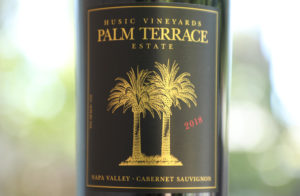
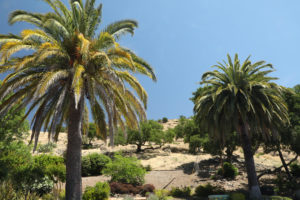
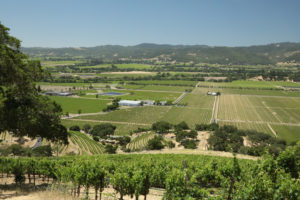 The Husic Pinot Noir is sourced from the Lynch Vineyard each year, a site located approximately between Sebastopol and Occidental in neighboring Sonoma County. The vineyard site is steep with well drained loamy soils planted to four clones of Pinot Noir originally brought over from Burgundy.
The Husic Pinot Noir is sourced from the Lynch Vineyard each year, a site located approximately between Sebastopol and Occidental in neighboring Sonoma County. The vineyard site is steep with well drained loamy soils planted to four clones of Pinot Noir originally brought over from Burgundy.
The 2019 Husic Pinot Noir is medium ruby; the bouquet is dark and savory with notes of dry mushroom, damp potting soil, library books, dried bay leaf, smoked sage, old cedar box and raspberry. The character driven aromas are spice forward and take the front seat, with the fruit hanging out in the rear. However, the fruit makes its presence felt more on the palate with flavors of raspberry, cherry cola and red plum along with crushed pink peppercorn. Savory is a good descriptor for both the bouquet and the palate. The mouth feel is exceptionally soft and supple across the palate; the seamlessly integrated tannins showcase a gentle kiss on the finish. Lingers with a note of dried herbs including sage. Pair with assorted smoked meats or something from the BBQ covered in a spicy dry rub, such as lamb. This vineyard is close to the source of their Chardonnay near Occidental in Sonoma County – and also not far from the cooling waters of the Pacific Ocean.
The 2015 Husic Vineyards Pinot Noir initially shows earthy notes with some wood spice but as it opens reveals beautiful fruit aromas (mostly raspberry). Nicely balanced and supple on the palate shows mostly red fruits including cherry. Offers a bit of weight mid palate without being heavy. Clean and supple on the finish with long lasting flavors and a lingering red cherry tartness.
The 2018 Husic Palm Terrace Estate Cabernet Sauvignon is a blend from all three of their vineyards; this wine is deep ruby and opaque. The bouquet smells like the variety without being too ripe or under ripe; we like that. It offers scents of red chili spice, pipe tobacco, a hint of menthol, old cedar box, blackberry, dark raspberry, Santa Rosa plum and a nuance of dark chocolate. It is balanced and approachable with resolved and rounded tannins sporting a creamy-like texture. Flavors include blackberry, boysenberry, Santa Rosa plum and dark cherry. Lingers juicy, with notes of sweet tobacco spice, dark pepper, dried herbs including sage and a lasting light chalky character. The savory finish showcases both flavor and a gentle texture paralleling each other. This wine was aged in more second-fill barrels than the Husic Cabernet Sauvignon which sees more new French oak barrels.
The 2018 Husic Cabernet Sauvignon is deep ruby and opaque; the bouquet offers scents of dried rose petals, smoked sage, sweet tobacco and assorted baking spices including clove, cardamom and nutmeg accompanied by loads of fruit: dark cherry, blackberry, spiced plum and boysenberry. As the wine evolves in the glass it offers additional scents of dark chocolate and espresso. There is simply ‘more’ here in terms of aromatic depth, complexity and character on the palate than the Palm Terrace Estate bottling. Its texture is one of its hallmark attributes showcasing a moderate grainy grip with a persistent and chalk like character. The palate is primarily dark fruited with flavors of plum, blackberry, cherry and boysenberry. The extended finish offers notes of dried herbs and tobacco. This is a serious wine for serious collectors and has plenty of life ahead of it, 6 years post vintage at the time of our tasting.
The 2012 Husic Vineyards Cabernet Sauvignon reveals aromas of black cherry and black currant along with a noticeable sweetness of fruit including notes of liqueur; the bouquet is unwavering in its aromatic presentation, even with additional time in the glass. Shows hints of hints of oak spice, but these are subtleties – certainly not what one first notices on the bouquet. On the palate there is more red fruit than darker fruit with well-integrated tannins and a kiss of mocha showing on the long finish. This wine is more linear in its presentation than the 2013.
The 2013 Husic Vineyards Cabernet Sauvignon immediately offers darker fruit on the bouquet with aromas of mushroom, oak spice, white pepper and an earthy nuance. As it opens more fruit shows including aromas of blackberry and boysenberry. The palate reveals darker fruits including blackberry and black cherry complemented by excellent acidity. This is a robust wine with layers of flavor that complement the bigger tannins on this vintage as compared to the 2012. We would love to try this bottling 10 years from its vintage.
Due to issues with the extended heat spike centered around Labor Day in 2022, Husic did not produce any estate wines.
—

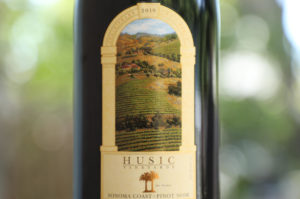 The wines are selectively distributed in the U.S including in Florida, Georgia (Atlanta), North Carolina and Texas. Production during a robust year as been as high as 2,000 cases, but is currently under 1,000 cases. Internationally the wines have been in select locations within Canada and Japan. Frank and Julie have also found a specific niche for marketing their wines – using wine dinners at various country clubs and restaurants as excellent venues for introducing new customers to their wines. And Julie also showcases the Husic wines at private tastings hosted by club members across the country. For a few years they were a winery partner at Ma(i)sonry in Yountville where one could taste the current releases of the Husic wines.
The wines are selectively distributed in the U.S including in Florida, Georgia (Atlanta), North Carolina and Texas. Production during a robust year as been as high as 2,000 cases, but is currently under 1,000 cases. Internationally the wines have been in select locations within Canada and Japan. Frank and Julie have also found a specific niche for marketing their wines – using wine dinners at various country clubs and restaurants as excellent venues for introducing new customers to their wines. And Julie also showcases the Husic wines at private tastings hosted by club members across the country. For a few years they were a winery partner at Ma(i)sonry in Yountville where one could taste the current releases of the Husic wines.
In October 2017 terrible brush fires raced across the slopes of the Vaca mountains devouring significant portions of parts of hillsides within Atlas Peak and the Stags Leap District. While the landscape surrounding much of Husic Vineyards was seared by the fires, remarkably the two homes on the property survived. However, some vines were burned but have since been replanted. And the two palm trees next to the swimming pool on the property whose likeness is prominently featured on the label of the Palm Terrace bottling, also survived. However both trees were significantly burned with the blackened palm fronds dropping into the pool; in the aftermath of the fire, the Husic’s thought the trees were killed. However, the top of the trees began to grow again and today one can never tell they were burned. Their olive trees also were severely burned but have since recovered.
The Caves at Soda Canyon
The Caves At Soda Canyon is a premium underground winery that offers both production and hospitality space for a limited number of small wineries. The Husic wines are produced here. The property is located in Atlas Peak and is a short drive from the Husic property. While only around a 20 minute drive from downtown Napa, the feel here is definitely hillside remote.
We first visited many years ago when it was just under the initial stages of construction. Our early visit was with visionary for The Caves at Soda Canyon, vintner Ryan Waugh who was accompanied by winemaker Craig MaClean. It opened in late 2013 and initially its focus was on production space with limited hospitality available for wines produced by the original four founding winery members: Waugh, Lobo, Patland and Buoncristiani Family Winery. In 2020 a wing of the cave was finally opened for hospitality; over the years the cave is now used for both production and hospitality by additional small family-owned brands. One can make an appointment directly with these brands to taste only their wines, including Husic, or one can make an appointment directly with The Caves at Soda Canyon (where a tasting will highlight select wines from some of the producers).
In the face of natural disasters, this winery has two strong advantages, and it has already been tested twice since opening. Advantage number one is its underground location and advantage number two is it is built into what essentially looks like a giant rock pile. The winery survived the Napa earthquake of 2014 without loss of product (despite significant damage to the relatively nearby city of Napa) and during the Atlas Peak fire of October 2017, again the wine was safe as the fire did not come into the cave, yet it burned all the landscape around the winery and even partially melted some of their outside tanks and the asphalt of their parking lot.
This winery offers a luxurious and well lighted interior alcove for tastings (one of our pet peeves is always caves with bad lighting – one will not find that here), as well as a beautiful space on an outdoor terrace overlooking much of the central to southern part of the valley including the San Francisco skyline in the distance on an exceptionally clear day. An upper outdoor space can also be used for tastings and offers expansive vistas of the southern part of Napa Valley. Select Husic wines are included in tastings hosted at the Caves at Soda Canyon. Groups are hosted privately using one of several hospitality spaces, either indoors or outdoors.
Library wines dating back to the earliest vintages are available in a limited supply. For more information, to schedule a tasting, to purchase wines or to join their wine club, visit: www.husicvineyards.com






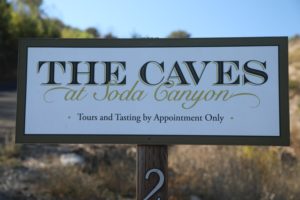
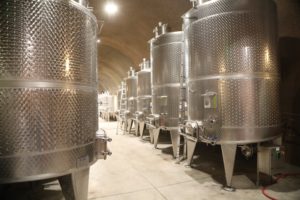

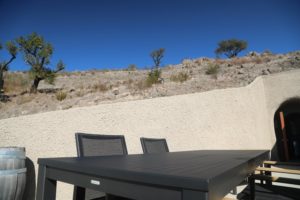
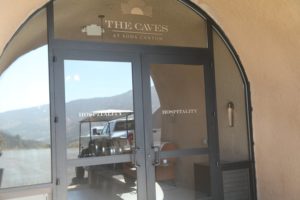
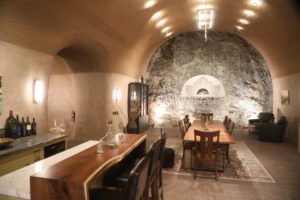
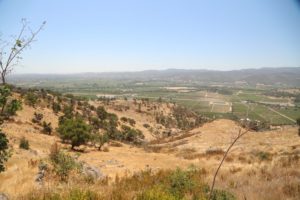
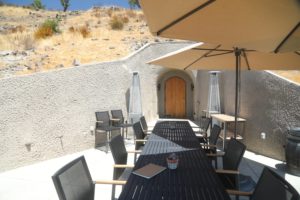
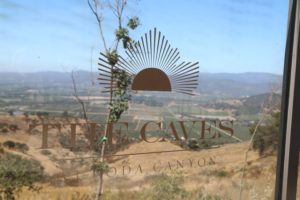
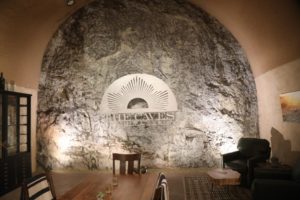
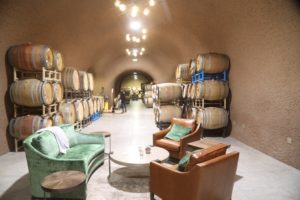
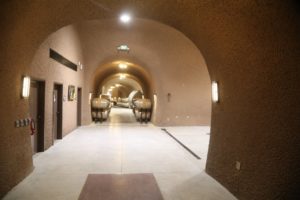
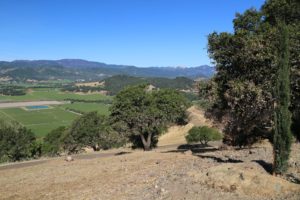
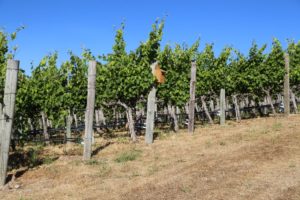
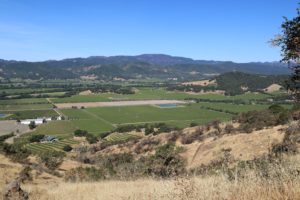
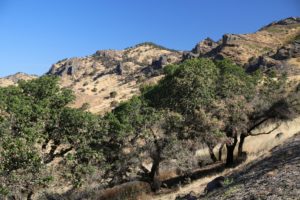
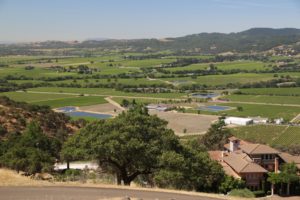
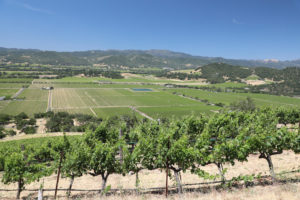
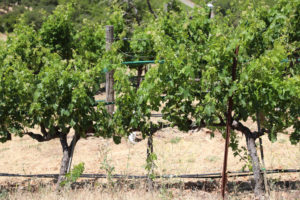
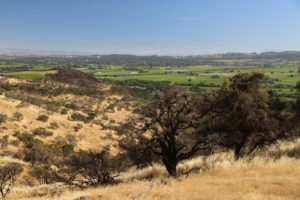
Leave a Reply